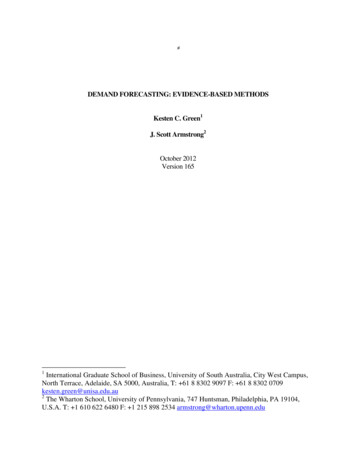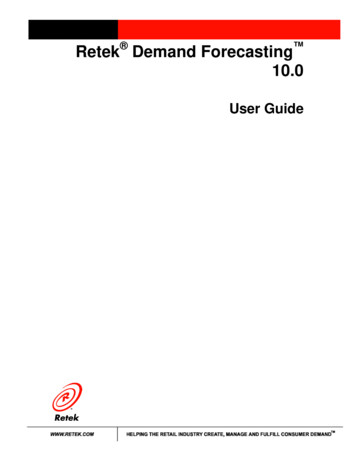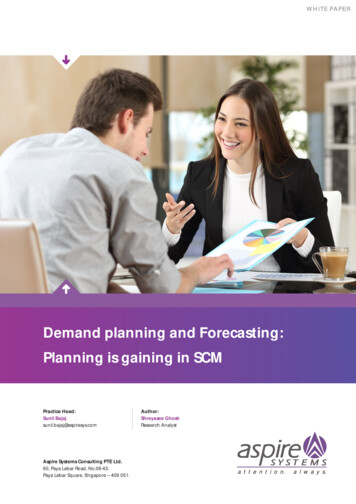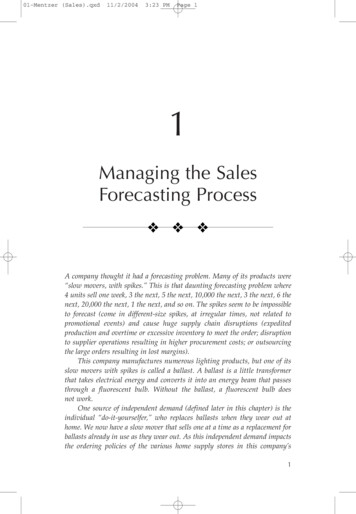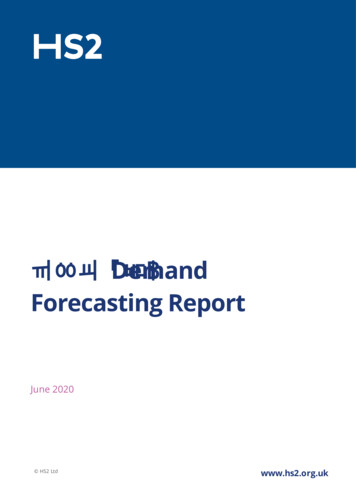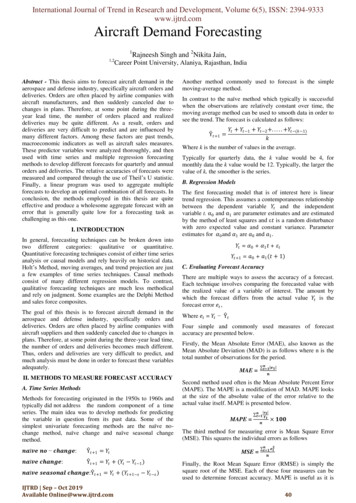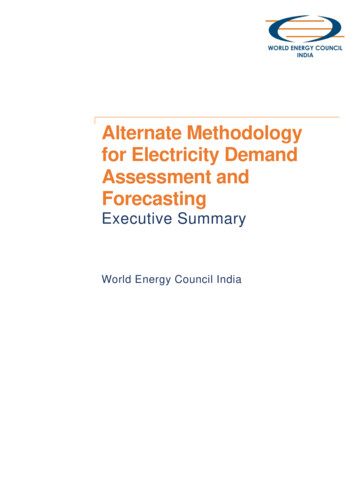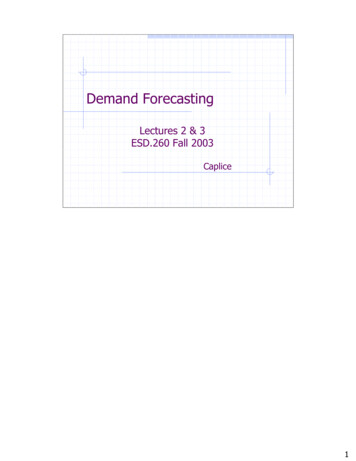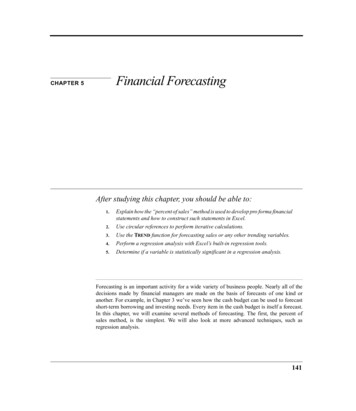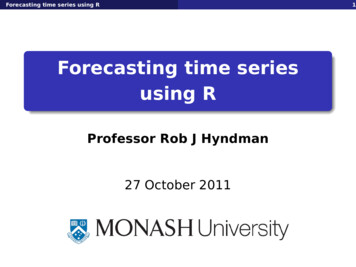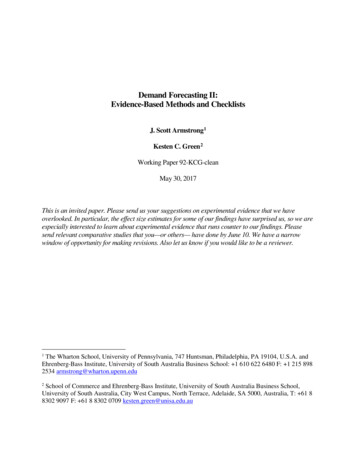
Transcription
Demand Forecasting II:Evidence-Based Methods and ChecklistsJ. Scott Armstrong1Kesten C. Green2Working Paper 92-KCG-cleanMay 30, 2017This is an invited paper. Please send us your suggestions on experimental evidence that we haveoverlooked. In particular, the effect size estimates for some of our findings have surprised us, so we areespecially interested to learn about experimental evidence that runs counter to our findings. Pleasesend relevant comparative studies that you—or others— have done by June 10. We have a narrowwindow of opportunity for making revisions. Also let us know if you would like to be a reviewer.1The Wharton School, University of Pennsylvania, 747 Huntsman, Philadelphia, PA 19104, U.S.A. andEhrenberg-Bass Institute, University of South Australia Business School: 1 610 622 6480 F: 1 215 8982534 armstrong@wharton.upenn.edu2School of Commerce and Ehrenberg-Bass Institute, University of South Australia Business School,University of South Australia, City West Campus, North Terrace, Adelaide, SA 5000, Australia, T: 61 88302 9097 F: 61 8 8302 0709 kesten.green@unisa.edu.au
Demand Forecasting II:Evidence-Based Methods and ChecklistsJ. Scott Armstrong & Kesten C. GreenABSTRACTProblem: Decision makers in the public and private sectors would benefit from more accurate forecasts ofdemand for goods and services. Most forecasting practitioners are unaware of discoveries from experimentalresearch over the past half-century that can be used to reduce errors dramatically, often by more than half. Theobjective of this paper is to improve demand forecasting practice by providing forecasting knowledge toforecasters and decision makers in a form that is easy for them to use.Methods: This paper reviews forecasting research to identify which methods are useful for demandforecasting, and which are not, and develops checklists of evidence-based forecasting guidance for demandforecasters and their clients. The primary criterion for evaluating whether or not a method is useful was predictivevalidity, as assessed by evidence on the relative accuracy of ex ante forecasts.Findings: This paper identifies and describes 17 evidence-based forecasting methods and eight that are not,and provides five evidence-based checklists for applying knowledge on forecasting to diverse demandforecasting problems by selecting and implementing the most suitable methods.Originality: Three of the checklists are new—one listing evidence-based methods and the knowledgeneeded to apply them, one on assessing uncertainty, and one listing popular forecasting methods to avoid.Usefulness: The checklists are low-cost tools that forecasters can use together with knowledge of all 17useful forecasting methods. The evidence presented in this paper suggests that by using the checklists,forecasters will produce demand forecasts that are substantially more accurate than those provided by currentlypopular methods. The completed checklists provide assurance to clients and other interested parties that theresulting forecasts were derived using evidence-based procedures.Key words: big data, calibration, competitor behavior, confidence, decision-making, government services,market share, market size, new product forecasting, prediction intervals, regulation, sales forecasting, uncertaintyAuthors’ notes: Work on this paper started in early 2005 in response to an invitation to provide a chapter fora book. In 2007, we withdrew the paper due to differences with the editor of the book over “content, level, andstyle.” We made the working paper available on the Internet from 2005 and updated it from time to time throughto 2012. It had been cited 75 times by April 2017 according to Google Scholar. We decided to update the paper inearly 2017, and added “II” to our title to recognize the substantial revision of the paper including the addition ofrecent developments in forecasting and the addition of five checklists. We estimate that most readers can read thispaper in one hour.1. We received no funding for the paper and have no commercial interests in any forecasting method.2. We endeavored to conform with the Criteria for Science Checklist at GuidelinesforScience.com.Acknowledgments: We thank Hal Arkes, Roy Batchelor, David Corkindale, Robert Fildes, Paul Goodwin,Andreas Graefe, Kostas Nikolopoulos, and Malcolm Wright for their reviews. We also thank those who madeuseful suggestions, including Phil Stern. Finally, we thank those who edited the paper for us: Esther Park, MayaMudambi, and Scheherbano Rafay.2
INTRODUCTIONDemand forecasting asks how much of a good or service would be bought, consumed, orotherwise experienced in the future given marketing actions, and industry and market conditions.Demand forecasting can involve forecasting the effects on demand of such changes as product design,price, advertising, or the actions of competitors and regulators. This paper is concerned with improvingthe accuracy of forecasts by making scientific knowledge on forecasting available to demandforecasters.Accurate forecasts are important for businesses and other organizations in making plans tomeet demand for their goods and services. The need for accurate demand forecasts is particularlyimportant when the information provided by market prices is distorted or absent, as when governmentshave a large role in the provision of a good (e.g., medicines), or service (e.g., national park visits.)Thanks to findings from experiments testing multiple reasonable hypotheses, demandforecasting has advanced rapidly since the 1930s. In the mid-1990s, 39 leading forecasting researchersand 123 expert reviewers were involved in identifying and collating scientific knowledge onforecasting. These findings were summarized as principles (condition-action statements). One-hundredand-thirty-nine principles were formulated (Armstrong 2001b, pp. 679-732). In 2015, two papersfurther summarized forecasting knowledge in the form of two overarching principles: simplicity andconservatism (Green and Armstrong 2015, and Armstrong, Green, and Graefe 2015, respectively). Theguidelines for demand forecasting described in this paper draw upon those evidence-based principles.This paper is concerned with methods that have been shown to improve forecast accuracyrelative to methods that are commonly used in practice. Absent a political motive that a preferred planbe adopted, accuracy is the most important criterion for most parties concerned with forecasts (Fildesand Goodwin 2007). Other criteria include forecast uncertainty, cost, and understandability. Yokumand Armstrong (1995) discuss the criteria for judging alternative forecasting methods, and show howresearchers and practitioners ranked the criteria.METHODSWe reviewed research findings and provided checklists to make this knowledge accessible toforecasters and researchers. The review involved searching for papers with evidence from experimentsthat compared the performance of alternative methods. We did this using the following procedures:1) Searching the Internet, mostly using Google Scholar.2) Contacting key researchers for assistance, which, according one study, is far morecomprehensive than computer searches (Armstrong and Pagell, 2003).3) Using references from key papers.4) Putting working paper versions our paper online (e.g., ResearchGate) with requests forpapers that might have been overlooked. In doing so, we emphasized the need forexperimental evidence, especially evidence that would challenge the findings presented inthis paper.5) Asking reviewers to identify missing papers.6) Sending the paper to relevant lists such as ELMAR in marketing.7) Posting on relevant websites such as ForecastingPrinciples.com.Given the enormous number of papers with promising titles, we screened papers by whetherthe “Abstracts” or “Conclusions” reported the findings and methods. If not, we stopped. If yes, we3
checked whether the paper provided full disclosure. If yes, we then checked whether the findings wereimportant. Of the papers with promising titles, only a small percentage passed these criteria.The primary criterion for evaluating whether or not a method is useful was predictive validity,as assessed by evidence on the accuracy of ex ante forecasts from the method relative to those fromcurrent practice or to existing evidence-based alternative methods. These papers were used to developchecklists for use by demand forecasters, managers, clients, investors, funders, and citizens concernedabout forecasts for public policy.CHECKLISTS TO IMPLEMENT AND ASSESS FORECASTING METHODSWe summarize knowledge on how best to forecast in the form of checklists. Structuredchecklists are an effective way to make complex tasks easier, to avoid the need for memorizing,to provide relevant guidance on a just-in-time basis, and to inform others about the proceduresyou used.Checklists are useful for applying evidence-based methods and principles, such as withflying an airplane or performing a medical operation. They can also inform decision-makers ofthe latest scientific findings.Much research supports the value of using checklists (see, e.g., Hales and Pronovost2006). One experiment assessed the effects of using a 19-item checklist for a hospital procedure.The before-and-after design compared the outcomes experienced by thousands of patients inhospitals in eight cities around the world. The checklist led to a reduction in deaths from 1.5% to0.8% in the month after the operations, and in complications, from 11% to 7% (Haynes et al.2009).While the advances in forecasting knowledge over the past century have provided theopportunity for substantial improvements in accuracy, most practitioners do not make use of thatknowledge. There are a number of reasons why that happens: practitioners (1) prefer to stick with theircurrent forecasting procedures; (2) wish to provide support for a preferred outcome; (3) are unaware ofevidence-based methods; or (4) are aware of the evidence-based methods, but they have not followedany procedure to ensure that they use them, and they have not been asked to do so. Practitioners whoare not using evidence-based forecasting methods for reasons 3 or 4 will benefit from reading this paperand using the checklists provided.Practitioners are unaware of evidence-based methods (reason number 3) because the usual waythaeylearn about a subject—by reading a textbook—would not have made them aware. At the time thatthe original 139 forecasting principles were published, a review of 17 forecasting textbooks found thatthe typical textbook mentioned only 19% of the principles. At best, one textbook mentioned one-thirdof the principles (Cox and Loomis 2001).Failure to comply with known evidence-based procedures (reason number 4) can be cured byrequiring practitioners to complete a checklist. When clients specify the procedures they require,practitioners will try to comply, especially when they know that their processes will be audited.This paper presents checklists to aid funders in asking forecasters to provide evidencebased forecasts, policy makers to assess whether forecasts can be trusted, and forecasters toensure that they are following proper methods and could thus defend their procedures in court, ifneed be. They can also help clients to assess when forecasters follow proper procedures. Whenthe forecasts are wildly incorrect—think of the forecasts made on and around the first Earth Dayin 1970, such as the “Great 1980s Die-Off” of 4 billion people, including 65 million Americans(Perry 2017)—forecasters might be sued for failing to follow proper procedures in the same waythat medical and engineering professionals can be sued for negligence.4
VALID FORECASTING METHODS: DESCRIPTIONS AND EVIDENCEExhibit 1 provides a listing of all 17 forecasting methods that have been found to havepredictive validity. For each of the methods, the exhibit identifies the knowledge that is needed—inaddition to knowledge of the method—to use the method for a given problem. The forecaster should beaware of evidence from prior experimental research that is relevant to the forecasting problem. For thegreat majority of forecasting problems, several of the methods listed in Exhibit 1will be usable.Practitioners typically use the method they are most familiar or the method that they believe tobe the best for the problem to hand. Both are mistakes. Instead, forecasters should familiarizethemselves with all of the valid forecasting methods and seek to use all that are feasible for theproblem. Further, forecasters should obtain forecasts from several implementations of each method,and combine the forecasts. At a minimum, we suggest forecasters should obtain forecasts from twovariations of each of three different methods in order to reduce the risk of extreme errors.5
The predictive validity of a theory or a forecasting method is assessed by comparing theaccuracy of forecasts from the method with forecasts from the currently used method, or from a simpleplausible method, or from other evidence-based methods. For qualitative forecasts—such as whether a,b, or c will happen, or which of x or y would be better—accuracy is typically measured as somevariation of percent correct. For quantitative forecasts, accuracy is assessed by the size of the forecasterrors. Forecast errors are measures of the absolute difference between ex ante forecasts and whatactually transpired. Much of the evidence on the forecasting methods described in this paper is,therefore, presented in the form of percentage error reductions attributable to using the method ratherthan the commonly used method, or some other benchmark method.Evidence-based forecasting methods are described next. We start with judgmental methods,and follow with quantitative methods. The latter inevitably require some judgment.Judgmental MethodsTo be useful, understandable, unbiased and replicable, judgmental forecasting methods must bestructured and fully disclosed. Contrary to common belief, being expert on a topic or problem is notsufficient to make accurate forecasts in complex situations.Prediction markets (1)Prediction markets—also known as betting markets, information markets, and futuresmarkets—aim to attract experts who are motivated to use their knowledge to win money by makingaccurate predictions, thus being less likely to be biased. Markets have been long been used to makeforecasts. For example, in the 1800s, they provided the primary way to forecast political elections(Graefe 2017). If you are wondering about the relevance to demand of forecasting the outcomes of U.S.presidential elections, consider that election results and the actions of the new incumbent can haveimportant effects on markets.Prediction markets are especially useful when knowledge is dispersed and many motivatedparticipants are trading. In addition, they rapidly revise forecasts when new information becomesavailable.The advent of software and the Internet means that prediction markets are practical for moreforecasting problems. Forecasters using the prediction markets method will need to be familiar withdesigning online prediction markets, as well as with evidence-based survey design.The accuracy of forecasts from prediction markets was tested across eight publishedcomparisons in the field of business forecasting; Errors were 28% lower than those from no-changemodels, but 29% higher than those from combined judgmental forecasts (Graefe 2011). In another test,forecasts from prediction markets across the three months before each U.S. presidential election from2004 to 2016 were, on average, less accurate than forecasts from the RealClearPolitics poll average, asurvey of experts, and citizen forecasts (Graefe, 2017). We suspect that the small number ofparticipants and the limit on each bet ( 500) harmed its effectiveness. Still, prediction marketscontributed substantially to improving the accuracy of combined forecasts of voting for politicalcandidates.Judgmental Bootstrapping (2)Judgmental bootstrapping was discovered in the early 1900s, when it was used to makeforecasts of agricultural crops. The method uses regression analysis on the variables that experts use tomake judgmental forecasts. The dependent variable is not the actual outcome, but rather the experts’6
predictions of the outcome given the values of the causal variables. As a consequence, the method canbe used when one has no actual data on the dependent variable.The first step is to ask experts to identify causal variables based on their domain knowledge.Then ask them to make predictions for a set of hypothetical cases. For example, they could be asked toforecast the short-term effect of a promotion on demand given features such as price reduction,advertising, market share, and competitor response. By using hypothetical features for a variety ofalternative promotions, the forecaster can ensure that the causal variables vary substantially andindependently of one another. Regression analysis is then used to estimate the parameters of a modelwith which to make forecasts. In other words, judgmental bootstrapping is a method to develop amodel of the experts’ forecasting procedure.Interestingly, the bootstrap model’s forecasts are more accurate than those of the experts. It islike picking oneself up by the bootstraps. The result occurs because the model is more consistent thanthe expert in applying the rules. It addition the model does not get distracted by irrelevant features, nordoes it get tired or irritable. Finally, the forecaster can ensure that the model excludes irrelevantvariables.Judgmental bootstrapping models are especially useful for complex forecasting problems forwhich data on the dependent variable—such as sales for a proposed product—are not available. Oncedeveloped, the bootstrapping model can provide forecasts at a low cost and make forecasts for differentsituations—e.g., by changing the features of a product.Despite the discovery of the method and evidence on its usefulness, its early use seemed tohave been confined to agricultural predictions. The method was rediscovered by social scientists in the1960s. The paved the way for an evaluation of its value. A meta-analysis found that judgmentalbootstrapping forecasts were more accurate than those from unaided judgments in 8 of 11 comparisons,with two tests finding no difference and one finding a small loss in accuracy. The typical errorreduction was about 6%. The one failure occurred when the experts relied on an irrelevant variable thatwas not excluded from the bootstrap model (Armstrong 2001a.) A study that compared financialanalysts’ recommendations with recommendations from models of the analysts found that trades basedon the models’ recommendations were more profitable (Batchelor and Kwan 2007).In the 1970s, in a chance meeting on an airplane, the first author sat next to Ed Snider, theowner of the Philadelphia Flyers hockey team. Might he be interested in judgmental bootstrapping? Iasked him how he selected players. He told me that he visited the Dallas cowboys football team to findout why they were so successful. The Cowboys, as it happened, were using judgmental bootstrapping,so that is what the Flyers were then using. He also said he asked his management team to use it, butthey refused. He did, however, convince them to use both methods as a test. It took only one year forthe team convert to judgmental bootstrapping. Snider said that the other hockey team owners knewwhat the Flyers were doing, but they preferred to continue using their unaided judgments.In 1979, when the first author was visiting a friend, Paul Westhead, then coach of the LosAngeles Lakers basketball team, he suggested the use of judgmental bootstrapping. Westhead wasinterested, but was unable to convince the owner. In the 1990s, a method apparently similar tojudgmental bootstrapping—regression analysis with variables selected by experts—was adopted by thegeneral manager of Oakland Athletics baseball team. It met with fierce resistance from baseball scouts,the experts who historically used a wide variety of data along with their judgment. The improvedforecasts from the regression models were so profitable, however, that today almost all professionalsports teams use some version of this method. Those that do not, pay the price in their won-loss tally.Despite the evidence, judgmental bootstrapping appears to be ignored by businesses, where thewon-lost record is not clear-cut. It is also ignored by universities for their hiring decisions despite the7
fact that one of the earliest validation tests showed that it provided a much more accurate and much lessexpensive way to decide who should be admitted to PhD programs (Dawes 1971),Judgmental bootstrapping can also reduce bias in hiring employees, and in admitting studentsto universities, by insisting that the variables are only included if they have been shown to be relevantto performance. Orchestras have implemented this principle since the 1970s by holding auditionsbehind a screen. The approach produced a large increase in the proportion of women in orchestrasbetween 1970 1996. (Goldin and Rouse 2000).Multiplicative decomposition (3)Multiplicative decomposition involves dividing a forecasting problem into multiplicative parts.For example, to forecast sales for a brand, a firm might separately forecast total market sales andmarket share, and then multiply those components. Decomposition makes sense when forecasting theparts individually is easier than forecasting the entire problem, when different methods are appropriatefor forecasting each individual part, and when relevant data can be obtained for some parts of theproblem.Multiplicative decomposition is a general problem structuring method that should be used inconjunction with other evidence-based methods listed in Exhibit 1 for forecasting the component parts.For example, judgmental forecasts from multiplicative decomposition were generally more accuratethan those obtained using a global approach (see MacGregor, 2001).Intentions surveys (4)Intentions surveys ask people how they plan to behave in specified situations. Data fromintentions surveys can be used, for example, to predict how people would respond to major changes inthe design of a product. A meta-analysis covering 47 comparisons with over 10,000 subjects, and ameta-analysis of ten meta-analyses with data from over 83,000 subjects each found a strongrelationship between people’s intentions and their behavior (Kim and Hunter 1993; Sheeran 2002).Intentions surveys are especially useful when historical demand data are not available,such as for new products or in new markets. They are most likely to provide accurate forecasts whenthe forecast time horizon is short, and the behavior is familiar and important to the respondent, such aswith durable goods. Plans are less likely to change when they are for the near future. (Morwitz 2001;Morwitz, Steckel, and Gupta 2007). Intentions surveys provide unbiased forecasts of demand, soadjustments for response bias are not needed (Wright and MacRae 2007).To forecast demand using the intentions of potential consumers, prepare an accurate but briefdescription of the product (Armstrong and Overton 1977). Intentions should be obtained by usingprobability scales such as 0 ‘No chance, or almost no chance (1 in 100)’ to 10 ‘Certain, orpractically certain (99 in 100)’ (Morwitz 2001). Evidence-based procedures for selecting samples,obtaining high response rates, compensating for non-response bias, and reducing response error aredescribed in Dillman, Smyth, and Christian (2014).Response error is often a large component of error. The problem is especially acute when thesituation is new to the people responding to the survey, as when forecasting demand for a new productcategory; think mobile phones that fit easily in the pocket when they first became available. Intentionssurveys are especially useful for forecasting demand for new products and for existing productsin new markets because most other methods require historical data.8
Expectations surveys (5)Expectations surveys ask people how they expect themselves, or others, to behave.Expectations differ from intentions because people know that unintended events might interfere, andare subject to wishful thinking. For example, if you were asked whether you intend to catch the bus towork tomorrow, you might say, “yes”. However, because you realize that doing so is less convenientthan driving and that you sometimes miss your intended bus, your expectation might be that there isonly an 80% chance that you will go by bus. As with intentions surveys, forecasters should follow bestpractice survey design, and should use probability scales to elicit expectations.Following the U. S. government’s prohibition of prediction markets for political elections,expectation surveys were introduced for the 1932 presidential election (Hayes, 1936). A representativesample of potential voters was asked how they expected others might vote, known as a “citizenforecasts.” These citizen expectation surveys have predicted the winners of the U.S. Presidentialelections from 1932 to 2012 on 89% of the 217 surveys (Graefe 2014).Further evidence was obtained from the PollyVote project. Over the 100 days before theelection, the citizens’ expectations forecast errors for the seven U.S. Presidential elections from 1992through 2016 averaged 1.2% compared to the combined polls of likely voters’ (voter intentions)average error of 2.6%; an error reduction of 54% (Graefe, Armstrong, Jones, and Cuzán 2017).Citizen forecasts are cheaper than the election polls, because the respondents are answering for manyother people, so the samples can be smaller. We expect that the costs of the few citizen surveys wouldbe a small fraction of one percent of the cost of the many election polls that are used.Expectations surveys are often used to obtain information from experts. For example, askingsales managers about sales expectations for a new model of a computer. Such surveys have beenroutinely used for estimating various components of the economy, such as for short-term trends in thebuilding industry.Expert surveys (6)Use written questions and instructions for the interviewers to ensure that’s each expert isquestioned in the same way, thereby avoiding interviewers’ biases. Word the question in more than oneway in order to compensate for possible biases in wording, and average across the answers. Pre-testeach question to ensure that the experts understand what is being asked. Additional advice on thedesign for expert surveys is provided in Armstrong (1985, pp.108-116).Obtain forecasts from at least five experts. For important forecasts, use up to 20 experts(Hogarth 1978). That advice was followed in forecasting the popular vote in the seven U. S.presidential elections up to and including 2016. Fifteen or so experts were asked for theirexpectations on the popular vote in several surveys over the last 96 days prior to each election.The average error of the expert survey forecasts was, at 1.6%, substantially less than the averageerror of the forecasts from poll aggregators, at 2.6% (Graefe, Armstrong, Jones, and Cuzán 2017,and personal correspondence with Graefe).Delphi is an extension of the above survey approach whereby the survey is given in two ormore rounds with anonymous summaries of the forecasts and reasons provided as feedback after eachround. Repeat the process until forecasts change little between rounds—two or three rounds are usuallysufficient. Use the median or mode of the experts’ final-round forecasts as the Delphi forecast.Software for the procedure is available at ForecastingPrinciples.com.Delphi forecasts were more accurate than forecasts made in traditional meetings in five studiescomparing the two approaches, about the same in two, and were less accurate in one. Delphi was moreaccurate than surveys of expert opinion for 12 of 16 studies, with two ties and two cases in which9
Delphi was less accurate. Among these 24 comparisons, Delphi improved accuracy in 71% and harmedit in 12% (Rowe and Wright 2001.)Delphi is attractive to managers because it is easy to understand, and the record of the experts’reasoning can be informative. Delphi is relatively cheap because the experts do not need to meet. It hasan advantage over prediction markets in that reasons are provided for the forecasts (Green, Armstrong,and Graefe 2007). Delphi is likely to be most useful when relevant informations is distributed amongthe experts (Jones, Armstrong, and Cuzán 2007).Simulated interaction (role playing) (7)Simulated interaction is a form of role-playing that can be used to forecast decisions by peoplewho are interacting. For example, a manager might want to know how best to secure an exclusivedistribution arrangement with a major supplier, how customers would respond to changes in the designof a product, or how a union would respond to a contract offer by a company.Simulated interactions can be conducted by using naïve subjects to play the roles. Describe themain protagonists’ roles, prepare a brief description of the situation, and list possible decisions.Participants adopt one of the roles, then read the situation description. The role-players are asked toengage in realistic interactions with the other role players, staying in their roles until they reach adecision. The simulations typically last less than an hour.Relative to the method usually used for such situations—unaided expert judgment—simulatedinteraction reduced forecast errors on average by 57% for eight conflict situations (Green 2005). Theconflicts used in the research that were most relevant to the problem of demand forecasting includeunion-management disputes, an attempt at the hostile takeover of a corporation, and a supply channelnegotiation.If the simulated interaction method seems onerous, you might think that following th
Demand forecasting asks how much of a good or service would be bought, consumed, or otherwise experienced in the future given marketing actions, and industry and market conditions . Demand forecasting can involve forecasting the effects on demand of such changes as product design, price, advertising, or the actions of competitors and regulators.
